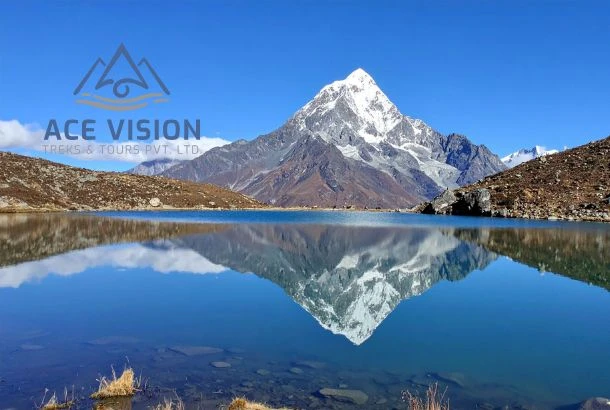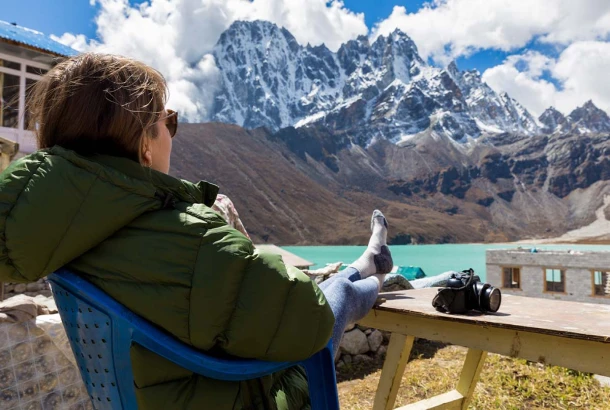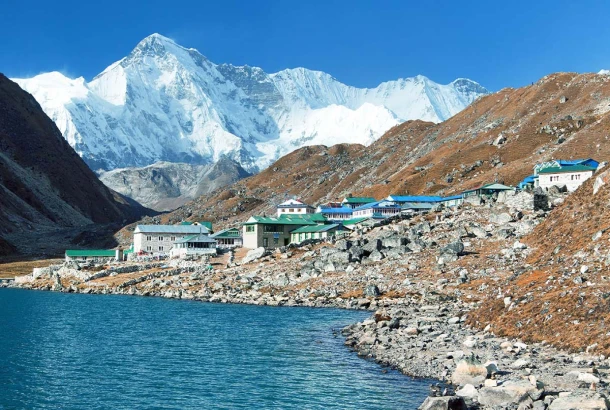Mera Peak Climbing Difficulty Factors

Altitude
Mera Peak stands at 6,476 meters and is the most elevated trekking peak in Nepal. At this level of altitude, the air is thin, so there is less oxygen available for your body. This is perhaps one of the biggest challenges climbers face since altitude sickness might set in.
If your body does not get sufficient time to acclimatize, you may experience symptoms such as headache, nausea, breathlessness, dizziness etc. Hence, proper acclimatization is required in order to avoid severe health hazards related to altitude.
Uncertain Mountain Weather
The weather in the Himalayas can be unpredictable and frequently changing. Climbers on Mera Peak have to endure subfreezing temperatures, high winds and abrupt shifts in weather. These challenge your stamina and call for the right equipment and mental toughness.
Inclement weather can also slow down the advancement of the journey or add risk increasing the overall degree of difficulty.
Tough Terrain
The ascent to the summit of Mera Peak involves mixed terrain ranging from glacier walks, snowfields, rocky trails and steep ridges. The trails are in their raw and wild form which are hard to negotiate. Most of all, glacier walks are sensitive because of hidden crevasses and icy surfaces. Such mixed terrain necessitates you to have a good balance as well as confidence in traversing diverse surfaces.
Duration and Daily Distances
Mera Peak climbing excursion would typically last 18 to 20 days, based on the itinerary and acclimatization schedule. Trekking distances per day are mixed but are usually around 5 to 10 kilometers. Usually, the itinerary includes moderate daily walking distances with adequate time for acclimatization which makes it easy to continue on the expedition.
You will be trekking for multiple days on complex mountainous terrains. The chill and rugged high-altitude environment adds to the challenge and you will need stamina to handle several days of continuous physical effort. Climbers who precondition with cardiovascular and strength training will find the climb less strenuous and more pleasant.
Remote and Wilderness Location
Mera Peak is located in one of the most remote and untouched areas of the Nepalese Himalayas. It offers you a genuine mountaineering experience with wilderness trails, fewer facilities and fewer crowds. The expedition needs thoughtful planning because medical centers and help are not easily accessible. Such remoteness adds to the adventure as well as the challenge of the climb.
Preparations for Mera Peak Difficulty

Physical Fitness
Mera Peak takes you to alpine altitudes where the air has very little oxygen than at sea level. That is why your heart and lungs have to work a lot harder to deliver oxygen to your muscles and organs. If you do not possess cardiovascular endurance and muscular strength, you may experience fatigue, breathlessness and slow recovery.
Aerobic training like running, swimming and cycling strengthens your heart and lungs. Likewise, activities such as planks, deadlifts, squats etc let you handle the rough and sloping terrain easily. Such a way of physical conditioning increases your chance of a safe and successful Mera Peak climb tremendously.
Acclimatization Strategies
Altitude sickness in Mera Peak is common because of the high altitude nature of the expedition. It can ruin your health unless treated seriously. Preparing includes a thorough knowledge of acclimatization techniques. These involve climbing step by step to higher elevations, incorporating rest days and being aware of the symptoms of altitude sickness.
Well planned itineraries allow for gradual altitude gain. This gives the body time for adaptation to decreased oxygen levels. Speeding the ascent increases the likelihood of altitude sickness and may require going down. Proper acclimatization days and pacing are therefore critical to make the ascent successful and safe.
Choosing the Right Time of Expedition
It is essential to pick the correct time of year to do your Mera Peak climb. The ideal seasons are pre-monsoon (March to May) and post-monsoon (September to November). At these periods, the weather becomes stable, the skies are clear and the temperatures are moderate.
Attempting the climb during the monsoon or winter months means traversing muddy and slippery paths, deep snow, vast ice and an increased level of risk which will make the journey considerably more difficult and dangerous.
Mental Readiness
Ascent of Mount Mera is about enduring sub-freezing temperatures, unpredictable weather and multiple days in rugged highland regions. Mental toughness lets you focus on the experience and stay positive when things don't go according to plan. Visualization of success and the development of coping skills can be the dividing factor between overcoming obstacles and giving up your endeavor.
Hiring Guides and Porters
A trained professional mountain guide is central to high-altitude expeditions. They lead the route, track weather forecasts, watch over your health and make quick decisions for your security in case of changing conditions.
Guides are trained in mountain first aid, highly knowledgeable about the terrain and are usually proficient in English. Their assistance not only adds to your confidence but also greatly enhances your prospects of a successful and secure expedition.
Porters, nonetheless, carry your heavy food supply, tents and climbing gear so that you save your energy for the bodily exertion of climbing. Hiring porters not only reduces your physical burden but also benefits the economy and facilitates your expedition to run more smoothly and sustainably.
Packing the Right Gear and Clothing
High-altitude climbing demands special equipment: double-layered ice boots, crampons, insulated mittens, a down jacket and high-altitude sunglasses. Without it, you might get frostbite, hypothermia, or snow blindness. Mountaineering equipment like harnesses, helmets, and ice axes is mandatory in the glacier sections of Mera Peak.
Layered clothing is also crucial. Mera Peak temperature can fluctuate from scorching sun to subzero winds within a few hours. Wicking base layers, insulating layers of mid-weight and waterproof shells conserve body warmth and stay dry.
Buying a Comprehensive Travel Insurance
Climbing Mera Peak involves high-altitude hiking above 6,000 meters where altitude sickness, accidents and other illnesses may occur. Your travel insurance must cover emergency helicopter evacuation, medical bills, baggage loss and trip cancellation. Paying for insurance gives you confidence, which allows you to focus on your climb instead of worst-case scenarios.
Booking Package Through a Trusted Operator
Booking your Mera Peak Expedition with a reliable trekking operator gives you an organized, safe and legally compliant trip. We handle everything from permits, logistics, guides, porters and emergency arrangements. Climbing with a licensed outfitter like Ace Vision Treks and Tours reduces your concern and increases your chances of success by introducing structure, security and support to the climb.
Practice Basic Climbing Skills
While Mera Peak is one of the more easily accessible (trekking peak and less technical) Himalayan mountains, it is not suitable for novices with no preparation. Previous experience of high-altitude trekking or some basic mountaineering skills makes the ascent less difficult and safer.
Ascent to the summit without training and preparation will expose you to accidents, falls or injuries. You need to know how to use basic mountaineering equipment like crampons, ice axes, harnesses and fixed ropes. The gear is meant to make it possible for you to traverse snowfields and glaciers efficiently.

Who Can Climb Mera Peak?
Mera Peak climb is a non-technical but it does require a fair level of physical fitness and altitude acclimatization. The climb will be easier for those who have had some previous trekking experience in the Himalayas. Nevertheless, first-timers with determination and good preparation can also reach the summit successfully.
There is some simple mountaineering on the Mera Peak. You need to be experienced in the use of equipment like crampons and ice axes and in your ability to move about safely on snow and ice. Fixed ropes are set up in steeper sections for safety purposes, so you must be aware of how to use a harness and ascend or descend fixed ropes.
It also involves walking over glaciers and frozen steep terrain, requiring glacial travel techniques. You should be able to cope with heights, have no major medical conditions and be willing to learn some climbing techniques required.
For the most part, Mera Peak is within the reach of those adventurers who are mentally strong and physically capable enough for the challenge. With good leadership, an acclimatization schedule and determination, numerous climbers ranging from experienced to beginners can feel the incredible rewards of being on top of Nepal's tallest trekking peak.
Quick Tips for Overcoming Mera Peak Climb Difficulty
- Develop your muscular and cardiovascular endurance prior to climbing. Exercise such as cycling, swimming, running etc boosts your heart and lung function. Likewise, workouts like squats, plunges, planks etc improve your leg and core strength.
- Hire experienced local guides who are familiar with the Mera Peak route. They lead you through challenging sections easily and safely.
- Take proper trekking and mountaineering gear and layered clothing for a comfortable experience.
- Hydrate yourself by drinking lots of water and eat a healthy diet to avoid dehydration and illness.
- Avoid overexertion. Pay attention to your body and take a rest when you need to recharge your energy.
- Stay positive and focused and move ahead visualizing success.
- Be ready to adapt to weather changes or unexpected hurdles.
- Other than water, hydrate with electrolyte drinks to reverse a balance of salts and minerals lost through sweat at high altitude.
- Consult your doctor about medications like acetazolamide (Diamox) to help prevent altitude sickness if you are prone to it.
- Mera Peak involves glacier walking, rocky ridges and snowfields. Get accustomed to these conditions beforehand so that you are mentally prepared for the trek.
- Keep an eye on daily weather forecasts and avoid climbing during storms or heavy snowfall.
- Train prior to the expedition if you lack experience in using crampons, ice axes or ropes.
- Pack only what is needed to avoid needless strain. Lighter packs mean less energy spent and easier movement on steep slopes.
- High altitude means low temperatures. Use proper thermal layers, gloves, hats and socks to keep frostbite and hypothermia away.
- If you are not feeling well, let your guides know immediately so that they can slow you down or make decisions that will keep you safe.
- Select a well-scheduled itinerary with resting days and slow height ascension allowing for improved acclimatization.
Why Us for Your Mountain Adventure?
Are you daydreaming of an experience of a lifetime in the Himalayas? Ace Vision Treks and Tours can make it a reality. Whatever you are planning, be it a peaceful trek along serene trails or a demanding high altitude ascent, we offer support you can count on.
With friendly and professional service every step of the way, your experience is seamless, rewarding and simply unforgettable.
Our Mission
Ace Vision Treks and Tours was founded by passionate explorers with one mission in mind: to be Nepal's finest, most dependable and traveler focused trekking company. We are committed to offering motivational, environmentally conscious and personalized treks in the Himalayas.
By facilitating cultural exchange, environmental consciousness and exceptional service, we strive to leave a positive impact on both our guests and the communities we visit.
Experienced Local Team
Our team is made up of seasoned local guides and porters, all familiar with the landscape, climate, customs and cultures of where we travel. They are knowledgeable about the Himalayan environments and their warmth of hospitality makes you feel welcomed and well cared for throughout the journey.
As you travel with us, you are also supporting the local economy, helping to create employment opportunities and preserve natural and cultural heritage.
Customizable Travel Plans
We understand that every traveler is different. That's why we provide flexible, customized itineraries that work with your schedule, interests and style. You would like to delve deeper into culture, add extra time on the trek or make last minute adjustments along the way. We will customize your trip to meet your needs so you can relax and enjoy the experience.

High Success Rate on Expeditions
With a high trip success rate, Ace Vision Treks ensures you are in good hands. Our itineraries are carefully crafted to include proper acclimatization, realistic pacing and safety-first planning. Thanks to our experienced team and thoughtful preparation, countless adventurers have reached their Himalayan goals with confidence and joy.
No Hidden Fees
We offer clear and upfront pricing. When you book with us we will let you know exactly what you are getting and no hidden fees or extra tricks. This allows you to plan ahead with confidence and simply enjoy your trip without financial stress.
Simple and Secure Online Booking
Planning your trek has never been easier. Our easy booking process lets you search packages, read extensive itineraries, question everything and book your trip, all online. For greater one-on-one assistance, write to us at [email protected], or reach us in an instant on WhatsApp or call +977 9851025312.
Choose Your Own Guide
We know that the guide relationship can impact your entire experience. That is why we offer the option of selecting a guide of your preference (male or female), language skills or specific experience levels. All guides are licensed, first aid certified and dedicated to your comfort and well-being.
Focused on Guest Well-being
From the moment you contact us, we are committed to your peace of mind, comfort and care. We guide you in choosing the right trip, preparing and being ready at every step. Your health and well being are our concern and priorities before, during and after your trek.
Exclusive Private Tour
Want an even more personalized experience? We offer private tours entirely tailored to your needs and desires. Enjoy the luxury of going at your own speed, changing routes on a whim and having a guide and support staff all to yourself. It's your trip, we just help make it perfect.
Support for Last-Minute Travelers
In Nepal already? We do last-minute reservations as well. We can arrange everything, quickly and effectively, from permits to gear to guides, so your adventure can start right away.
Industry-Leading Trekking Company
Ace Vision Treks is run by a committed team of professionals with over 13 years of guiding treks in Nepal's most renowned and adventurous routes. Our trek managers, leaders and travel planners are passionate about the mountains and are motivated to deliver outstanding experiences for every client.
With deep local knowledge and careful planning, we help you overcome every obstacle and achieve triumph on your Himalayan adventure.
Mera Peak Climbing Difficulty - FAQs
What is the Level of Mera Peak Climbing Difficulty in Nepal?
Mera Peak climb difficulty is moderate for individuals possessing good physical health and trekking experience. Although it is not technically challenging, the high altitude, low temperatures, thin air, cold winds and the stamina required for several days of exertion add to the difficulty.
Likewise, the day of the summit involves the use of basic mountaineering gear on snow, ice and glaciers.
Is Mera Peak Ascent Suitable for Novice Climbers?
Yes, climbing Mera Peak in Nepal is achievable for beginners who are well trained. It is a great introductory mountaineering peak in the Himalayas. The ascent of this peak requires less technical ability, although some prior trekking or high altitude experience is strongly recommended.
Do I Need Technical Mountaineering Experience for Mera Peak Climb?
Since Mera Peak is a trekking peak, no advanced mountaineering skills are required. But you will be walking on snow and glaciers which necessitates some fundamental climbing qualities. Crampon work, use of an ice axe and harness, along with fixed rope travel and safety, are essential.
Pre-summit training sessions are typically included where you will learn about these techniques. Likewise, experienced guides will be there to assist you through the climb.
What Permits Are Required for the Mera Peak Climb?
The necessary permits for the Mera Peak climb are:
- Makalu Barun National Park Entry Permit
- Khumbu Pasang Lhamu Rural Municipality Entry Permit (Local Area Permit)
- Mera Peak Climbing Permit
What is the Overall Experience of Climbing Mera Peak?
The entire expedition of Mera Peak is strenuous, physically and mentally, but absolutely worth it. Climbers are treated to dramatic Himalayan scenery, isolation in remote valleys and stunning views of Everest, Lhotse, Makalu, Cho Oyu and Kanchenjunga from the summit.
Also Read:









